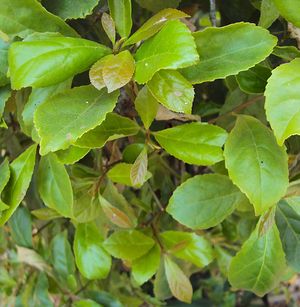Note: This is a project under development. The articles on this wiki are just being initiated and broadly incomplete. You can Help creating new pages.
Elaeocarpus serratus - Aravata
This is a tropical fruit found in the Indian Subcontinent, Indo-China and South East Asia. It is an ornamental medium sized tree indigenous to Sri Lanka, producing smooth, ovoid green fruits. The fruit has nutritive and medicinal values.The fruits are high in starch and sugar and have low amounts of protein and iron. It may help treat diarrhoea due to its constipating effect.It is an Asia-tropical fruit tree. Found in India - Karnataka, Kerala, Maharashtra, Tamil Nadu, Manipur, Assam and Nepal and Bangladesh and Sri Lanka in the Indian Subcontinent.
Contents
Uses
Dandruff, Abscesses, Fungal infections, Joint swelling, Eczemas, perspiration problems.
Parts Used
Chemical Composition
Atisine, Aconitine, Atisenol, Atidine, Hetisine, Hetisinone, Banzolheteratisine, Histidine, F-dihydroatisine, Heteratisine and Several diterpene alkaloids such aheterophyllin, heterophyllisin, heterophyllidine, and hetidine.[1]
Common names
| Language | Common name |
|---|---|
| Kannada | |
| Hindi | |
| Malayalam | |
| Tamil | karai, ulankarai |
| Telugu | |
| Marathi | NA |
| Gujarathi | NA |
| Punjabi | NA |
| Kashmiri | NA |
| Sanskrit | chiribilva- aravata |
| English | Ceylon Olive |
Habit
Identification
Leaf
| Kind | Shape | Feature |
|---|---|---|
| simple | spiral | Leaves simple, alternate, spiral, clustered at twig ends |
.[2]
Flower
| Type | Size | Color and composition | Stamen | More information |
|---|---|---|---|---|
| Inflorescence | 2-4cm long | white | Inflorescence racemes; flower petals white, laciniate, anthers ciliate |
Fruit
| Type | Size | Mass | Appearance | Seeds | More information |
|---|---|---|---|---|---|
| 7–10 mm (0.28–0.4 in.) long pome | s | {{{6}}} |
Other features
List of Ayurvedic medicine in which the herb is used
- Vishatinduka Taila as root juice extract
Where to get the saplings
Mode of Propagation
How to plant/cultivate
Members of this genus generally grow well in full sun to moderate shade, requiring a fertile, moist but well-drained soil[3]
Commonly seen growing in areas
Photo Gallery
References
External Links
- Pages that are stubs
- Ayurvedic Herbs known to be helpful to treat Dandruff
- Ayurvedic Herbs known to be helpful to treat Abscesses
- Ayurvedic Herbs known to be helpful to treat Fungal infections
- Ayurvedic Herbs known to be helpful to treat Joint swelling
- Ayurvedic Herbs known to be helpful to treat Eczemas
- Ayurvedic Herbs known to be helpful to treat perspiration problems
- Herbs with Root used in medicine
- Herbs with Leaves used in medicine
- Herbs with common name in Tamil
- Herbs with common name in Sanskrit
- Herbs with common name in English
- Habit - Evergreen Tree
- Index of Plants which can be propagated by Seeds
- Index of Plants which can be propagated by Cuttings
- Herbs that are commonly seen in the region of Trophical
- Herbs




